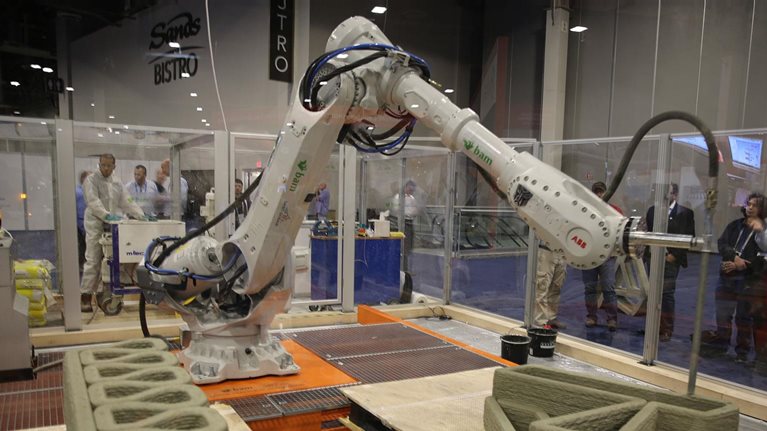Much of the infrastructure in which we live—our roads, our bridges, our buildings—is now designed and tested with increasingly sophisticated technology. Software-development company Bentley Systems has provided digital tools and services for some of the world’s most complex developments, including the Abu Dhabi International Airport and the Shard in London.
Stay current on your favorite topics
As a result, the company understands the challenges facing the infrastructure industry— from its engineers and architects, to IT managers and owners and operators—as it embraces and grows into the digital age. In this interview, Greg Bentley, CEO of Bentley Systems, discusses the skills the industry needs, the new technologies (such as digital twins, 4-D surveying, and cloud services) it can apply, and the role executive teams should play in improving digital literacy.
McKinsey: What is the construction workforce like today?
Greg Bentley: Demographic circumstances are understandably creating anxiety throughout infrastructure-project delivery. One estimate suggests that after 2008’s capital-markets tumult, the resulting austerity and waning number of projects reduced the construction workforce by 40 percent.1 Workers clearly wanted to escape the chronic cyclicality that characterizes much of construction.
There’s also been a secular demographic trend: failing to attract younger workers. In construction trades, less than 10 percent of the workforce today is under the age of 25—a figure much lower than in previous years.2 This demographic problem is already starting to constrain capacity, and I think everyone realizes it will get worse if the industry doesn’t change.
But there is a silver lining. The compelling solution to the quantitative and qualitative skills deficits in the infrastructure-project-delivery workforce is “going digital.” This offers the dual benefits of helping today’s limited supply of infrastructure and construction professionals become more productive, while at the same time attracting new young talent—digital natives—by changing the character and appeal of the work. In this way, going digital leads to a virtuous cycle.
McKinsey: What does going digital mean for the industry’s skills needs?
Greg Bentley: Going digital is the key to industrializing infrastructure delivery. It will help the industry catch up to manufacturing in turning formerly analog process into automated, digital workflows—templated, replicated, scaled, and progressively connected through information mobility that spans the project life cycle and across disciplines. To signify this, we use the terminology of a “4-D project digital twin,” which, for example, facilitates “constructioneering.” Here, the work of engineers and constructors is iterative, immersive, and interactive, rather than being discretely separated and sequenced. They need to be modeling and simulating projects together to take full advantage of modularization and automation.
Infrastructure project delivery, and especially construction, is fundamentally a 4-D endeavor. The needed new skills are dexterity with models, data, and digital dashboards. You’re collaborating virtually through cloud services for 4-D surveying with drones and digital imagery, and then machine learning from the progressive comparison at each stage between the physical twin and the engineer’s virtual twin.
Engineers and constructors are mechanically inclined and naturally adaptive. So they will find themselves becoming increasingly proficient in applying machine learning as their previously “dark” data is opened up—through intuitive immersive visualization—for analytics. By virtue of this anticipated skills-transition process, I tend to be bullish on generalists, more so than on narrow specialists, playing a greater role on future project-delivery teams. But all will benefit from comfort with at least some degree of coding and of business-intelligence virtuosity.

Voices on Infrastructure: Workforce of the future
McKinsey: How can the industry find or develop the skills necessary for constructioneering?
Greg Bentley: My hunch is that, fortunately, the skills to work with 4-D modeling already exist in our emerging workforce, but we may need to find them among the many young people who are currently attracted to computer gaming or who create animated environments for other industries’ purposes. We need only to entice them to work on our physical infrastructure, rather than their virtual worlds. Think about the type of digital visualization that the computer gamer takes for granted. Several years ago, Microsoft’s first HoloLens was primarily regarded as a gaming device; today, the HoloLens 2 is recognized as an industrial-grade tool with industrial-scale potential for infrastructure digital twins.
We need to ensure that the infrastructure professions are increasingly known and attractive to young people who have these generalist skills, these visualization skills, quantitative dispositions, and purposeful energy. Construction and engineering are far from routine; they are interesting and challenging, and they are rewardingly well suited for individuals with natural propensities for analytics, for imagining creative ways to use data, and for crafting with (machine-learned!) tools of the trade.
When a sector like ours talks about attracting workers, we can anticipate the fair questioning about whether current jobs will be lost to future robots. I would point out that robotics are used in heavy civil construction already. The first autonomous vehicles on many new roads are the machine-controlled excavators and graders driven by the constructioneers’ 4-D models. The results are better conditions, predictability, and safety of work, as well as greatly improved efficiency and economics of projects, which can lead to more work. Automation will not make the jobs of engineering and construction professionals scarcer, but rather safer and more rewarding.
McKinsey: What do executive teams need to do to help improve digital literacy?
Greg Bentley: Infrastructure-project executive teams should have an awareness and a zeal for these improvements. To me, the telling indicator is whether they regard technology as incremental overhead in producing their traditional deliverables, or whether they see it as the answer to minimizing scarce or unsafe labor, to improving work quality, to making more projects feasible, and to winning more lucrative and enduring work. In my experience, infrastructure CEOs generally recognize the compelling opportunities in going digital, but their vision is often thwarted by inflexible operating structures in their organizations.
I believe it’s preferable for executive teams to think about going digital not as an intimidating onetime “transformation,” but rather as a progressive process of increasingly connecting and automating workflows by useful (and ultimately self-financing) degrees. Infrastructure engineering leadership should enthusiastically and confidently embrace the potential improvement to their conventional business models—and the lessened vulnerability to the skills shortage we’ve talked about here—enabled by digital twins.
For me, a litmus test for whether an infrastructure-project-delivery organization is working to digitally future-proof itself is its commitment, or lack thereof, to explicitly investing in R&D. I don’t mean that engineers and constructors should be getting into the software business. Rather, they should create and capitalize intellectual property that advances their work toward valuable “infrastructure as a service” outcomes.
McKinsey: What are some specific actions that public- or private-sector groups can take to fuel going digital at an industry level?
Greg Bentley: I think that advocacy and full adoption for apprenticeship programs are a good start. Over the past few years, the United Kingdom (as a leader in joining private with public initiatives) created a high-speed rail college that offers handson instruction for digital advancement. Bentley Systems is one of the companies supporting this program, with hope that these students will graduate and bring knowledge of 4-D surveying and other digital tools and workflows to future projects.
From the software side, we can expand our contributions by providing not only the tools for infrastructure professionals but also the behind-the-scenes machine-learning environment to help each unique individual continuously improve in going digital. Together we can make up for the currently worsening infrastructure-project-delivery skills gap by attracting and empowering the right digital natives. In the end, if we get it right, perhaps a sustainable skills advantage will be our generation’s legacy.


